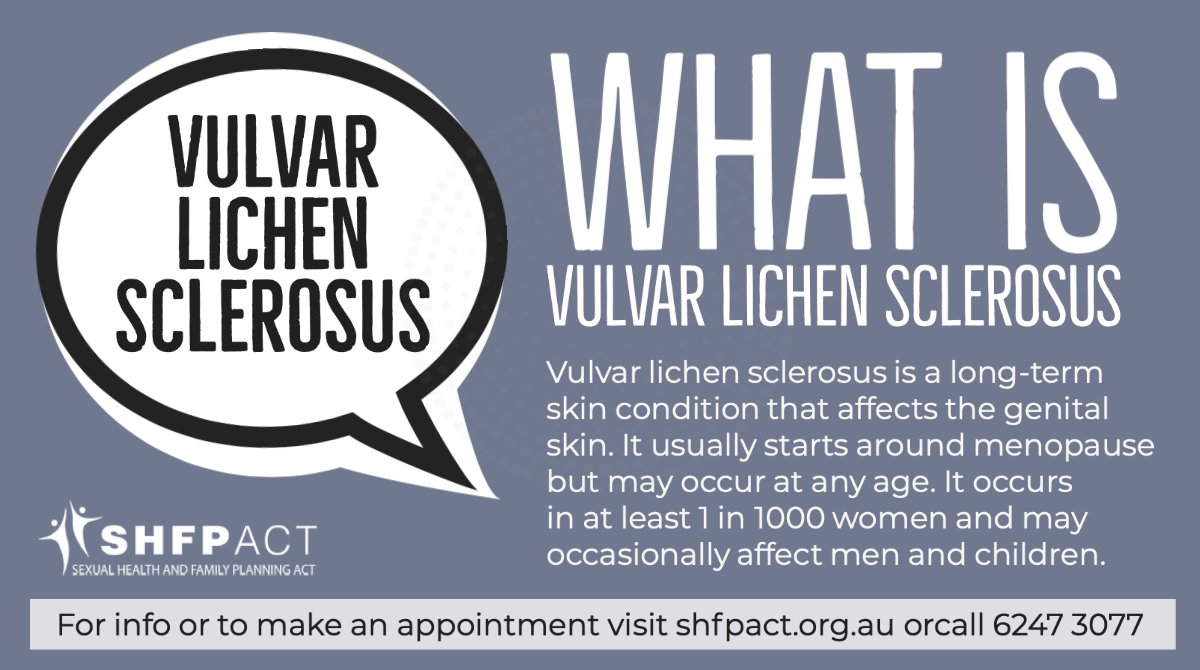Vulvar Lichen Sclerosus

What is Vulvar Lichen Sclerosus?
Vulvar lichen sclerosus is a long-term skin condition that affects the genital skin. It usually starts around menopause but may occur at any age. It occurs in at least 1 in 1000 women and may occasionally affect men and children. If lichen sclerosis is left untreated for a long time, there can be an increased risk of skin cancer in the vulva.
What causes it?
The cause of lichen sclerosus is unknown. It can sometimes be associated with autoimmune diseases. Autoimmune diseases occur when the cells and proteins that your body uses to fight off infection start to damage your body’s own tissues and prevent their normal actions. Your health care provider may do some blood tests to check for autoimmune diseases if they think this may be the case. Sometimes the disease may also occur in family members, but the risk of this is unknown.
What does it look like and what are the symptoms?
- Lichen sclerosis usually appears as pale, white, fragile skin patches that can sometimes look crinkled, but can also have a shiny smooth surface. These ca appear as individual patches or may involve the entire vulva, extending down to the skin around th anus. Lichen sclerosis does not involve the vagina.
- Itching is the most common symptom. This can sometimes be quite severe and may disturb sleep.
- Some people experience soreness and burning, particularly with intercourse
- Small cracks in the skin (fissures) and ulcers can occur because of scratching the skin. These can become very sore. If the anal skin splits, there can be pain with bowel movements.
- Some purplish/red areas may be also seen on the white background. These are bruises due to tiny areas of bleeding into the skin, often because of scratching.
- Scarring may occur due to the loss of vulvar tissue (the inner lips) or shrinkage of skin at the entrance to the vagina. This can cause pain and may interfere with sexual intercourse. It can sometimes cause pain with urination.
- In about 10% of individuals with vulvar lichen sclerosus, white patches may be seen on the skin elsewhere. The common sites for this are on the back, waist area, and under the breasts.
- Some people have no symptoms, and the diagnosis is made when the area is examined for another reason.
How is it diagnosed?
Health care providers familiar with the condition may diagnose vulvar lichen sclerosis by looking at your skin. The diagnosis is sometimes then confirmed by taking a skin biopsy. A biopsy involves numbing the skin with a local anesthetic, then removing a small piece of skin. This piece of skin is then looked at under the microscope. This is a simple procedure that can be done in the doctor’s office.
How do you treat it?
There is no cure for lichen sclerosus, but the symptoms can usually be controlled very well using strong steroid ointments. Using these ointments, the appearance and texture of the vulvar skin can improve. However, if there is already scarring, these changes may not be reversed. Proper treatment should prevent the development of further inflammation and scarring.
The treatment can be used safely in the genital area for this condition. Your health care provider will instruct you on how to use it correctly. It is important not to stop your treatment unless advised to by your health care provider, as lichen sclerosus can recur or progress without it.
Lichen sclerosis can be made worse by skin irritation, like scratching, or infections such as yeast or bacteria. Therefore, it is important to avoid skin irritation as much as possible. Any infections from yeast or bacteria need to be treated as soon as possible.
It is preferable to gently clean the vulva using water only over the skin surface, and avoiding any soap, gels, body wash etc. Some people prefer rinsing with a saline solution (a quarter of a teaspoon of salt dissolved in a cup of water).
How do I manage the symptoms?
Managing the itch:
You may feel itchy at times. This may be worse at a particular time of the day, usually at night. Scratching causes itchiness which makes you scratch more. This is called the itch-scratch response.
The itch-scratch response is normal but treatment with the steroid ointment will help this. Scratching the genital area is potentially harmful as it can damage the skin and keep the symptoms going or quite some time.
There are two strategies used for the itch:
- Firstly, the condition needs to be managed properly. this is a shared responsibility between you and your health care provider.
- Secondly, distraction can be very useful. This is something only you can do. For example, if the itch becomes unbearable when you are in bed, don’t lie there feeling uncomfortable and unable to resist scratching. Instead, get up and find something to do which occupies your hands and your attention. When you feel the tension from the itch is reduced, try going back to bed.
An antihistamine taken at bedtime may also help to control the itching. It is best to keep your nails short so scratching in your sleep does not damage the skin. If intercourse is painful, using a lubricant may help.
If dryness is a problem, and you are around the age of menopause, ask your health care provider about using vaginal oestrogen cream or pessaries to help with this. It’s safe to have sex but painful intercourse should be avoided as it can further irritate the affected skin.
GENITAL HERPES BROCHURE PDF
Last updated November 2020
SHFPACT is a health promotion charity (HPC) assisted with funding from the ACT Government..

